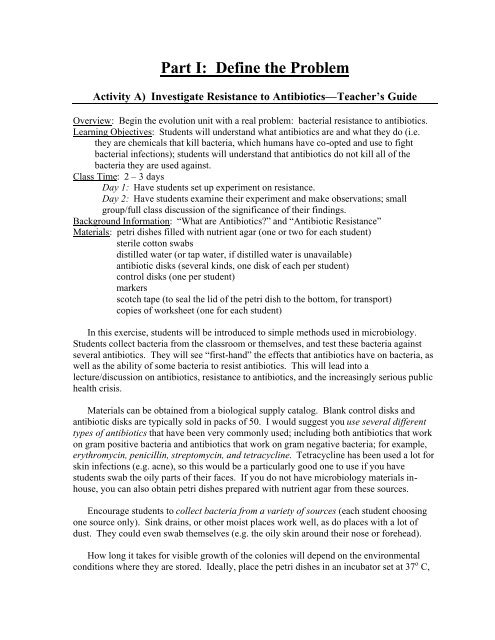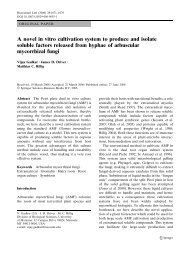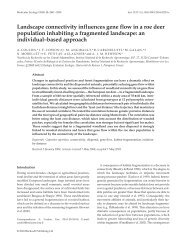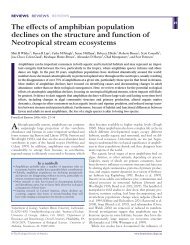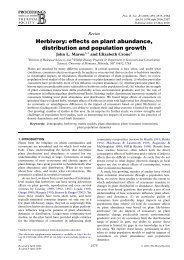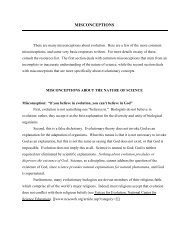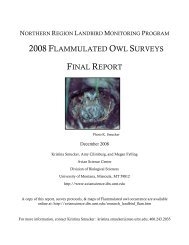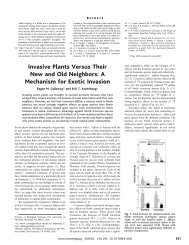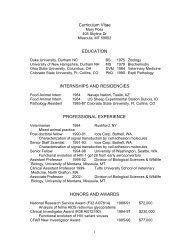Evolution of Antibiotic Resistance-Printable Format - Teach ...
Evolution of Antibiotic Resistance-Printable Format - Teach ...
Evolution of Antibiotic Resistance-Printable Format - Teach ...
You also want an ePaper? Increase the reach of your titles
YUMPU automatically turns print PDFs into web optimized ePapers that Google loves.
Part I: Define the Problem<br />
Activity A) Investigate <strong>Resistance</strong> to <strong>Antibiotic</strong>s—<strong>Teach</strong>er’s Guide<br />
Overview: Begin the evolution unit with a real problem: bacterial resistance to antibiotics.<br />
Learning Objectives: Students will understand what antibiotics are and what they do (i.e.<br />
they are chemicals that kill bacteria, which humans have co-opted and use to fight<br />
bacterial infections); students will understand that antibiotics do not kill all <strong>of</strong> the<br />
bacteria they are used against.<br />
Class Time: 2 – 3 days<br />
Day 1: Have students set up experiment on resistance.<br />
Day 2: Have students examine their experiment and make observations; small<br />
group/full class discussion <strong>of</strong> the significance <strong>of</strong> their findings.<br />
Background Information: “What are <strong>Antibiotic</strong>s?” and “<strong>Antibiotic</strong> <strong>Resistance</strong>”<br />
Materials: petri dishes filled with nutrient agar (one or two for each student)<br />
sterile cotton swabs<br />
distilled water (or tap water, if distilled water is unavailable)<br />
antibiotic disks (several kinds, one disk <strong>of</strong> each per student)<br />
control disks (one per student)<br />
markers<br />
scotch tape (to seal the lid <strong>of</strong> the petri dish to the bottom, for transport)<br />
copies <strong>of</strong> worksheet (one for each student)<br />
In this exercise, students will be introduced to simple methods used in microbiology.<br />
Students collect bacteria from the classroom or themselves, and test these bacteria against<br />
several antibiotics. They will see “first-hand” the effects that antibiotics have on bacteria, as<br />
well as the ability <strong>of</strong> some bacteria to resist antibiotics. This will lead into a<br />
lecture/discussion on antibiotics, resistance to antibiotics, and the increasingly serious public<br />
health crisis.<br />
Materials can be obtained from a biological supply catalog. Blank control disks and<br />
antibiotic disks are typically sold in packs <strong>of</strong> 50. I would suggest you use several different<br />
types <strong>of</strong> antibiotics that have been very commonly used; including both antibiotics that work<br />
on gram positive bacteria and antibiotics that work on gram negative bacteria; for example,<br />
erythromycin, penicillin, streptomycin, and tetracycline. Tetracycline has been used a lot for<br />
skin infections (e.g. acne), so this would be a particularly good one to use if you have<br />
students swab the oily parts <strong>of</strong> their faces. If you do not have microbiology materials inhouse,<br />
you can also obtain petri dishes prepared with nutrient agar from these sources.<br />
Encourage students to collect bacteria from a variety <strong>of</strong> sources (each student choosing<br />
one source only). Sink drains, or other moist places work well, as do places with a lot <strong>of</strong><br />
dust. They could even swab themselves (e.g. the oily skin around their nose or forehead).<br />
How long it takes for visible growth <strong>of</strong> the colonies will depend on the environmental<br />
conditions where they are stored. Ideally, place the petri dishes in an incubator set at 37 o C,


